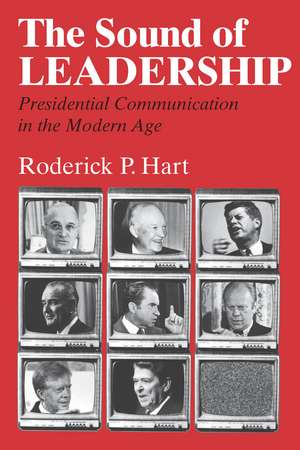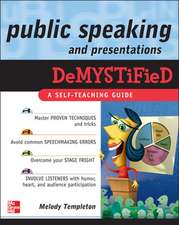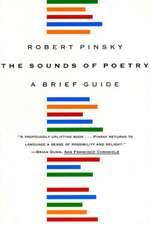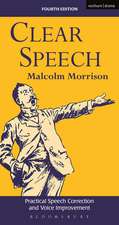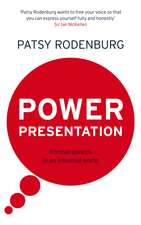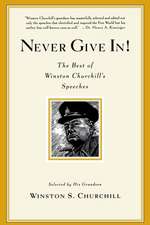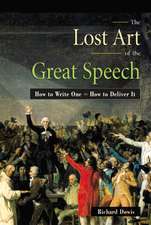The Sound of Leadership: Presidential Communication in the Modern Age
Autor Roderick P. Harten Limba Engleză Paperback – 31 iul 1987
Why did Gerald Ford speak in public once every six hours during 1976? Why did no president spreak in Massachusetts during one ten-year period? Why did Jimmy Carter conduct public ceremonies four times more often than Harry Truman? Why are television viewers two-and-a-half times more likely to see a president speak on the nightly news than to hear him speak?
The Sound of Leadership answers these questions and many more. Based on analysis of nearly 10,000 presidential speeches delivered between 1945 and 1985, this book is the first comprehensive examination of the ways in which presidents Truman through Reagan have used the powers of communication to advance their political goals. This communication revolution has produced, Roderick P. Hart argues, a new form of governance, one in which public speech has come to be taken as political action. Using a rhetorical appraoch, Hart details the features of this new American presidency by carefully examining when and where presidents spoke in public during the last four decades and what they said. Even though presidents have been speaking more and more, Hart reveals, they have been saying less and less. Rather than leading the nation, the modern president usually offers only the hollow "sound" of leadership. Written with great flair and acuteness, The Sound of Leadership will become a standard guide to the voices of modern presidential politics.
The Sound of Leadership answers these questions and many more. Based on analysis of nearly 10,000 presidential speeches delivered between 1945 and 1985, this book is the first comprehensive examination of the ways in which presidents Truman through Reagan have used the powers of communication to advance their political goals. This communication revolution has produced, Roderick P. Hart argues, a new form of governance, one in which public speech has come to be taken as political action. Using a rhetorical appraoch, Hart details the features of this new American presidency by carefully examining when and where presidents spoke in public during the last four decades and what they said. Even though presidents have been speaking more and more, Hart reveals, they have been saying less and less. Rather than leading the nation, the modern president usually offers only the hollow "sound" of leadership. Written with great flair and acuteness, The Sound of Leadership will become a standard guide to the voices of modern presidential politics.
Preț: 258.91 lei
Nou
Puncte Express: 388
Preț estimativ în valută:
49.56€ • 53.85$ • 41.66£
49.56€ • 53.85$ • 41.66£
Carte tipărită la comandă
Livrare economică 21 aprilie-05 mai
Preluare comenzi: 021 569.72.76
Specificații
ISBN-13: 9780226318134
ISBN-10: 0226318133
Pagini: 302
Ilustrații: 42 line drawings
Dimensiuni: 152 x 229 x 18 mm
Greutate: 0.36 kg
Ediția:1
Editura: University of Chicago Press
Colecția University of Chicago Press
ISBN-10: 0226318133
Pagini: 302
Ilustrații: 42 line drawings
Dimensiuni: 152 x 229 x 18 mm
Greutate: 0.36 kg
Ediția:1
Editura: University of Chicago Press
Colecția University of Chicago Press
Notă biografică
Roderick P. Hart is the F. A. Liddell Professor of Communication at the University of Texas, Austin. He is the author of Public Communication, The Political Pulpit, and Verbal Style and the Presidency.
Cuprins
Illustrations
Tables
Acknowledgments
Introduction
1. Speech and Effort: The New American Presidency
When Presidents Speak
On Stage in the White House
Rhetoric as Governance
The Kennedy Revolution
Consequences
Conclusion
2. Speech and Action: Building the Presidential Image
The Politics of Leadership
The Politics of Relationship
The Politics of Distraction
Conclusion
3. Speech and Power: The Tools of Presidential Leadership
Necessity: The Mother of Discourse
The Johnson Solution
The Nixon Solution
Speech as Commodity
Conclusion
4. Speech and Drama: The President versus the Mass Media
Words about Presidential Words
Orchestrating the Media
Orchestrating the Presidency
Conclusion
5. Speech and Choice: The Presidential Election
Talk as Solution
What Do Elections Do?
Rhetoric and Geography
Conclusion
6. Speech and Wisdom: Whither Presidents? Wither Leadership?
Whither Presidents?
Whither Leadership?
Conclusion
Appendix: Methods and Overall Data
Notes
Index
Tables
Acknowledgments
Introduction
1. Speech and Effort: The New American Presidency
When Presidents Speak
On Stage in the White House
Rhetoric as Governance
The Kennedy Revolution
Consequences
Conclusion
2. Speech and Action: Building the Presidential Image
The Politics of Leadership
The Politics of Relationship
The Politics of Distraction
Conclusion
3. Speech and Power: The Tools of Presidential Leadership
Necessity: The Mother of Discourse
The Johnson Solution
The Nixon Solution
Speech as Commodity
Conclusion
4. Speech and Drama: The President versus the Mass Media
Words about Presidential Words
Orchestrating the Media
Orchestrating the Presidency
Conclusion
5. Speech and Choice: The Presidential Election
Talk as Solution
What Do Elections Do?
Rhetoric and Geography
Conclusion
6. Speech and Wisdom: Whither Presidents? Wither Leadership?
Whither Presidents?
Whither Leadership?
Conclusion
Appendix: Methods and Overall Data
Notes
Index
